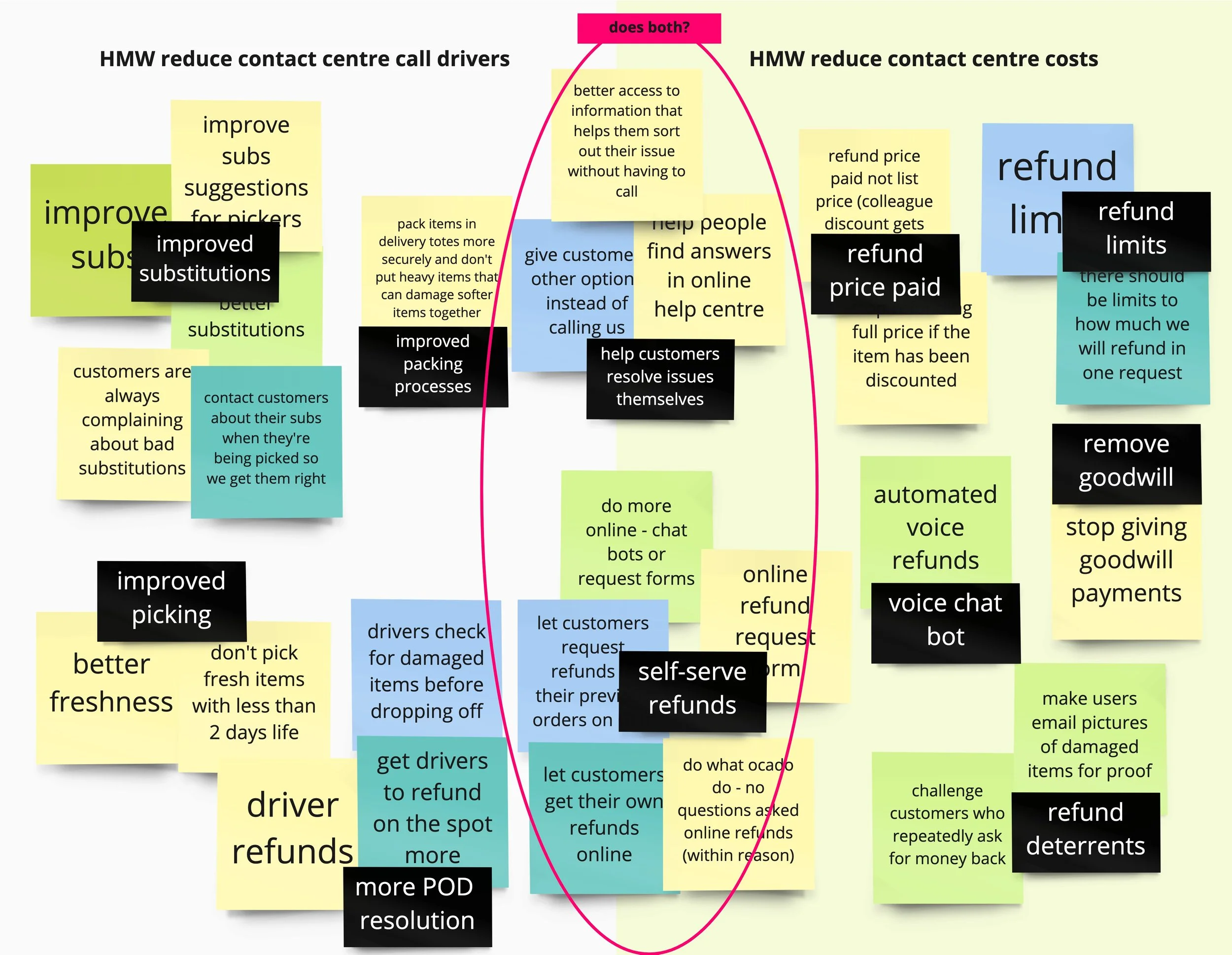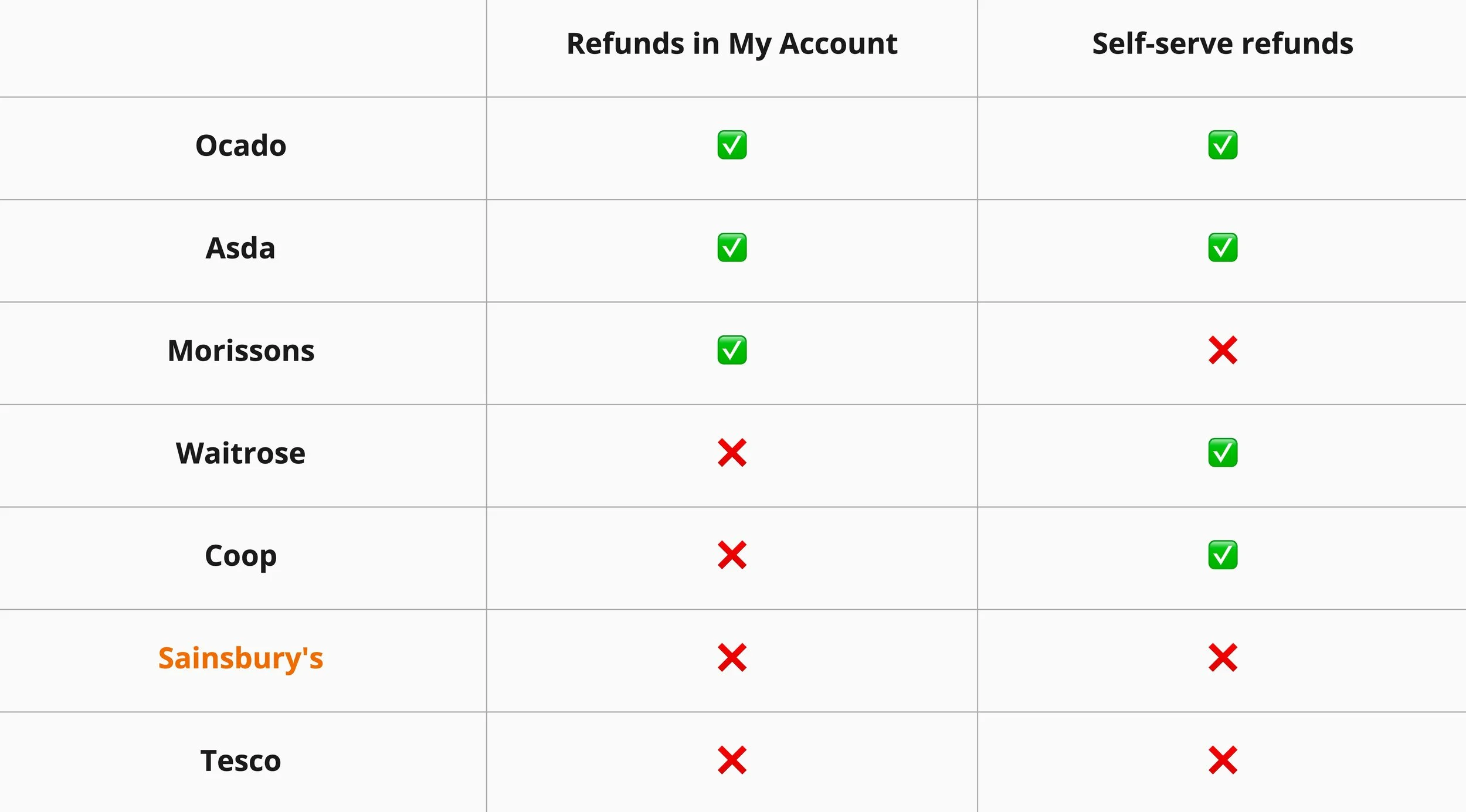
Self-serve refunds for Sainsbury’s
2020-21 / Lead product designer
Outcome: Save to invest / reduce cost to serve
In 2020 Sainsbury's set a business-wide goal to cut costs in order to invest in priority areas of the business.
In late 2020 I began working with the Sainsbury's contact centre to understand how I could help them identify and deliver on opportunities for cost saving while improving our existing customer journey.
Identifying an opportunity
We started by digging through excel spreadsheets detailing some of the costs that the contact centre sees every year, by far the biggest one was the cost to serve refunds, which in turn was caused by some issues with our existing customer experience.
The problem for the business…
Sainsbury’s receives 1390,000 calls a year requesting a refund, it takes 185,432 hours a year to process them and costs £3,800,000.
[image: lettuce know verbatim]
The problem for the customer…
Poor substitutions: if an item in their shop is unavailable, something else is delivered in it's place, with varying levels of success which leads to inconvenience and the need for a refund
Items missing from shop, damaged items, short shelf life of fresh goods
Phoning customer services: that's the only option available. At peak times a customer could be waiting for 20 minutes to speak to someone if something goes wrong with their shop. Potentially adding more inconvenience on top of an already frustrating issue.
How could we solve these problems?
I lead a working group of stakeholders consisting of business owners and product managers from fulfilment (bad substitutions etc), contact centre (how we put things right) and customer change (implementing new processes).
As a group we began generating ideas around how we could solve many of the issues the business and customer face.
Setting our scope
We started to build an idea fairly quickly that tackling the root cause of these costs was out of scope, for now at least. Implementing huge changes to grocery picking and delivery processes was a 2-3 year piece of work (which was, incidentally, due to start in 2021) and therefore considered out of scope.
[image: miro effort/impact]
We instead decided to work on mitigating the impact at point of contact which we believed we could do much sooner.
This meant saving the business money by reducing the number of refunds it processes while improving the customer’s experience by removing the need to spend time on the phone.
Generating hypotheses
Hypothesis #1 (customer benefit)
We believe that allowing customers to self-serve refunds will result in a positive impact to our customer's post-shop experience
Risks: customers do not value self-serve over a phone call, will not engage with this solution
Hypothesis #2 (business benefit)
We believe that allowing customers to self-serve refunds will result in a reduction in cost to serve
Risks: Sainsbury's is a highly risk-averse company and senior business owners believed that making refund requests easier could result in a larger number of requests, more items per request and increased costs.
Bonus hypothesis #3 (business benefit)
We believe that allowing customers to self-serve refunds will not result in an increase in refund requests, number of items per request or fraudulent requests
Initial validation and benchmarking
To begin to validate our first hypothesis, we wanted to understand what our customer's expectations were when it came to refunds and how they rated their experience of self-service compared to "face to face" interaction. To do so we had 200 users (of Sainsbury's and non-Sainsbury's customers) fill out a questionnaire about their experiences.
Shoppers prefer to self-serve
“Other retailers require multiple emails or phone calls - a simple online form makes it easier and quicker”
Sainsbury’s are behind their competitors
*refunds in my account refers to an “integrated” refund journey where a customer can request one directly from a previous orders screen
Worryingly, Sainsbury’s and Tesco are the only two major supermarkets not to offer a self-serve refund option
Building and learning from a proof of concept
Confident that the solution was what the customers wanted, we set out to build a basic form through which they could submit a refund request without speaking to customer services. It was extremely basic and did not seek to mitigate cost to serve but rather to prove whether the risks that we believe may compromise the viability of the solution were in fact an issue.
What we wanted to learn
What do customers think of this over our current refund process?
Do customers request more refunds?
Do customers request more items per refund?
Is there an increase in fraudulent requests?
How we can learn it
Release a form that allows customers to request a refund by filling out basic order details, selecting an item and a reason and submitting. The test will last for three months and we monitored KPIs throughout.
How we'll know if we're successful
Positive feedback from customers (via customer feedback tool)
No increase in refund requests
No increase in items per refund
No increase in fraudulent requests
Limitations
The form will not be promoted but instead linked to within our online help section alongside our telephone contact details so usage vol may be impacted.
Apart from the method of submission, nothing else will be automated, so the test will not provide insights on impacts to cost (although this was not critical, the level of certainty around the impact on cost saving was high).


